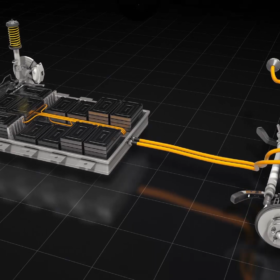Industry urges EU to boost self-consumption
After EU Parliament, Council and Commission each reached their respective position on the future of renewable energies in the EU until 2030, at the end of last year, representatives of the three bodies have commenced negotiations to find a EU wide position to be implemented as soon as possible. The renewable energy directive is expected to be ready for inking during this summer.
Fraunhofer ISE launches grid-stabilizing high-voltage inverter
The new inverter was developed in the HV-SiC project under the Future Electricity Grids funding program financed by the German Federal Ministry of Education and Research (BMBF). The inverter can regulate power currents of up to 10-15 kV more than ten times higher than regular silicon inverters. Fraunhofer says this makes new system architectures for power grids and plants conceivable.
Organic photovoltaics designed by AI at Osaka University
Cheap-to-produce OPV are the focus of research and although the struggle to get beyond 13% efficiency has hindered commercialization, organic PV can be made translucent, making it potentially ideal for applications such as PV-generating windows.
Toshiba to start power-to-gas supply chain demonstration in Japan
Toshiba has begun a large power-to-gas demonstration project in Japan. In spite of low efficiency and high prices, hydrogen is researched by many companies. In this demo, facilities are powered by Toshiba’s fuel cells, which receive hydrogen from an adjacent hydropower hydrogen generation facility.
Netherlands’ largest PV project reaches €41 million financial close
The nation’s largest solar plant – of 54 MW – has achieved financial close and tenders for plants exceeding 100 MW are in the pipeline
Suntech to supply 304 MW of modules to Voltalia
The news comes after Suntech recently announced a separate 116 MW module supply deal, with both orders related to Egypt’s mega Benban complex
Panasonic to use Meyer Burger’s SWCT in HIT module research
Panasonic has been improving the cost and durability of heterojunction cells for years. Meyer Burger’s smartwire connections could replace three-busbar technology and drive further advances
Enerray and Suntech ink contract for supply of 116 MW of modules for Benban
Italian developer Enerray is progressing three PV plants in Egypt’s Benban complex. The modules will be supplied by the Chinese manufacturer
Super fast EV charging solution secures BP Venture investment
British oil giant BP has announced a $20 million investment into battery developer Storedot, whose batteries use chemically synthesized organic molecules to build an organic polymer, in addition to lithium. Storedot says the astonishing properties of the new material enable electric vehicle charging times of just five minutes
Singulus and SERIS continue HJT research after proof of concept
By proving inductively coupled plasma can be used for HJT-cell production, the research institute and corporate partner will now work on ways to find cost-effective production methods with the aim of making a GW scale roll out of HJT cells viable










